mobile View, to the German Version tap the flag


- State of the Vatican City
- Papal States
- absolute electional monarchy
- own names:
Latin: Status Civitatis Vaticanæ
Italian: Sancta Sedes
- other designations:
Vatican, Vatican City State, Holy See, Saint-Siège, État de la Cité du Vatican, Stato Pontificio
• Flag
• historical Flags
• Meaning/Origin of the Flag
• Coat of Arms
• Meaning/Origin of the Coat of Arms
• Map of the Country
• Map of the historical states in Italy
• Numbers and Facts
• History
• Origin of the Country's Name
• Map of the today's regions of Italy
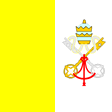
since 1929,
Flag of the Vatican,
ratio = 1:1,
Source, by: Wikipedia (D)






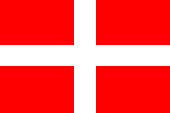
12th to 15th cent.,
Flag of the Papal States



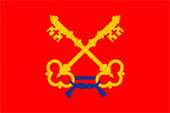
17th cent.to 1798, 1800–1803,
Flag of the Papal States



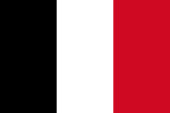
1798-1799,
Flag of the Roman Republic,
Source, by:
World Statesmen



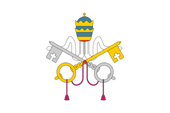
1803–1809,
Flag of the Papal States,
Source, by:
World Statesmen



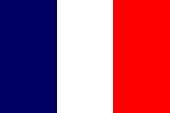
1809–1814,
Papal States belongs to France






1814–1829,
Flag of the Papal States,
Source, by:
World Statesmen



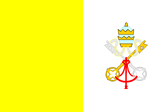
1829–1870,
Flag of the Papal States,
Source, by:
World Statesmen






Flag of the Catholic Church




The today's flag of Vatican City was officially introduced on 8th of July in 1929. It is square and shows two vertical stripes of yellow and white. In the middle of the white stripe are to see since the 13th century the papal symbols: the crown of the pope (Tiara) and two crossed keys (keys of Peter). Yellow (gold) and white (silver) were introduced by Pope Pius VII. in 1808 as the new papal colours, they were used on flags from 1829 too. They replaced theby then usual red and refer to the two keys from the coat of arms. One is a silver and one is gold. They stand for binding and loosing. The red cord between the keys symbolizes the joint work of both powers. The today's flag dates back to an older model that was used from 1829 to 1870, then officially rectangular, today officially square. In practice, however, are often used rectangular flags. The today's flag dates back to an older model that was used from 1829 to 1870, then officially rectangular, today officially square. In practice, however, are often used rectangular flags. The flag of Vatican City is also used at sea, and hoisted on the estates of the Vatican outside the actual territory, e.g. Castel Gandolfo. Each pope has his own personal flag. It is white and shows his own coat of arms in the middle, a combination of papal motives, and the coat of arms of his family. Before 1808 red was the color of the Vatican and the papal symbols have been used on red flags. In the Middle Ages and even into the Renaissance era red flags have been used with a continuous white cross. That was the model for many flags, which are still in use until today (e.g. Denmark), which were often granted by the popes. The Order of St. John still uses today, the papal flag of the middle ages.
Source: Flags of the World,
Die Welt der Flaggen,
Wappen und Flaggen aller Nationen,
Flaggen Wappen Hymnen,
Flaggen und Wappen der Welt

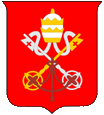
Coat of Arms of Vatican City State,
Source, by: Wikipedia (D)

The coat of arms was adopted in its present form with the Basic Law of the Vatican from 7th of June in 1929. It shows within a red shield the since the 13th century usual papal symbols: the crown of the pope (Tiara) and two crossed keys. These are the keys of Peter. They stand for binding and loosing. The red cord between the keys symbolizes the joint work of both powers. Red is the traditional papal color. The emblem was in use already before 1929. It emerged from the arms of Pope Martin V. (1417–1431). Every pope has his own personal coat of arms, a combination of papal motives, and the coat of arms of his family.
Source: Die Welt der Flaggen,
Wappen und Flaggen aller Nationen,
Flaggen Wappen Hymnen,
Flaggen und Wappen der Welt

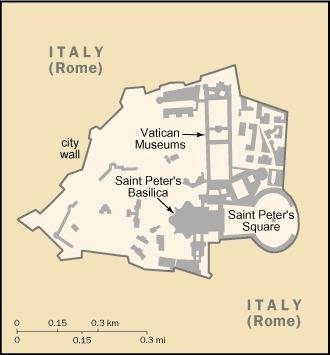
Source: CIA World Factbook

all state denominations in English:
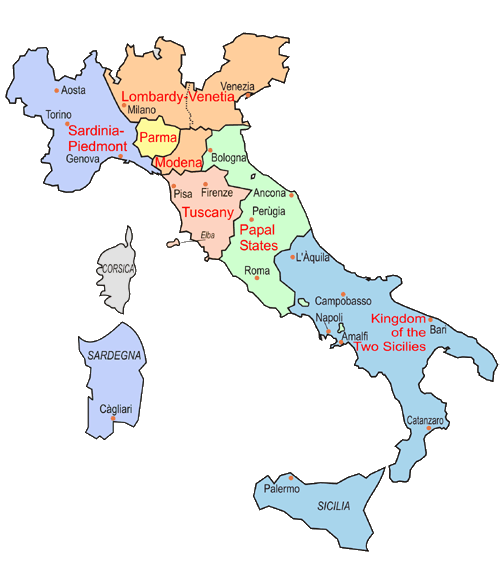
Source: Volker Preuß

Area: 0,17 square miles, ca. 1855: 15.902 square miles
Inhabitants: 453 inh. (2019), ca. 1855: 3.125.000 inh.
Density of Population: 2.666 inh./sq.mi., ca. 1855: 196 inh./sq.mi.
Capital: to 1870 Rome (ital.: Roma)
official Language: Latin
other Languages: Italian, German
Currency: 1 Euro (€, EUR) = 100 Cent, to 1866: Vatican Scudo
Time Zone: GMT + 1 h
Source: 1.) Wikipedia (D),
2.) Wikipedia (D),
Meyers Konversationslexikon

about 60 A.D. · The apostle Peter founds in Rome the Roman Church
since 4th century · by donations the Roman Church acquires properties, next to the city of Rome other areas in Italy
536–568 · except the Dukat of Rome, all possessions get lost by the conquest of the Byzantine Empire and the Lombards
754 · donation of Pippin, the Frankish King Pippin the Short hands over to the Pope Stephen II, some frome the Lombards conquered territories in Italy, including the city of Rome (Dukat of Rome), founding of the Papal States (Patrimony of St. Peter)
756 · Pippin extends the donation by the Exarchate of Ravenna and the Pentapolis (5 cities on the Adriatic Sea)
899–950 · Hungarians invasions
11th century · the Exarchate of Ravenna and the Pentapolis come temporarily to the Kingdom of Italy
1201 and 1213 · the Exarchate of Ravenna and the Pentapolis come back to the Papal States
1309–1377 · the popes reside in the city of Avignon in Venaissin (France)
1512 and 1598 · the duchies of Parma, Modena and Ferrara come temporarily to the Papal States
1796 · Italy Campaign of Napoléon
1798 · French troops of Napoléon marched into Rome, the Pope goes to Valence in France, the Papal States (Patrimonium Petri) become the "Roman Republic"
1799 · withdrawal of the French troops, invasion of troops from the Kingdom of Naples, the "Roman Republic" ends
1801 · concordat with France, restore of the Papal States
1809 · Napoléon annexes the Papal States
1813 · concordat with France, official abolition of the Papal States
1814 · defeat of Napoléonic France, the pope returnes to Rome
1815 · Congress of Vienna, restore of the Papal States
1860 · Umbria, Marches and the Romagna become annexed by Sardinia-Piedmont
1870 · the Papal State become annexed by Italy
7th of June 1929 · Lateran Treaty, restoration of the Papal States as a small state within the city of Rome (Vatican City)
6th of April 1964 · Vatican Cityis a permanent observer at the UN
Source: Meyers Konversationslexikon,
Atlas zur Geschichte,
1.) Wikipedia (D),
2.) Wikipedia (D)

Today's "Vatican City" continues the tradition of the "Papal States". Officially this land is called "State of Vatican City", in Latin "Status Civitatis Vaticanæ", in Italian "Stato della Città del Vaticano". Other names are "Sancta Sedes", what means "Holy See" and "Patrimonium Petri" the "Estate of Peter."
Source: Wikipedia (D)

all denominations in Italian
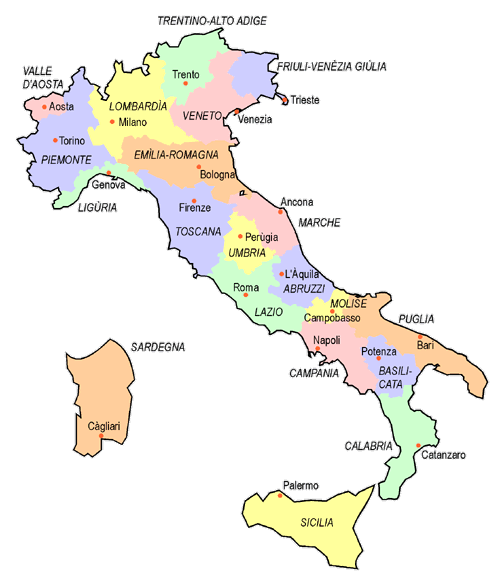
Source: Volker Preuß


![]()



































